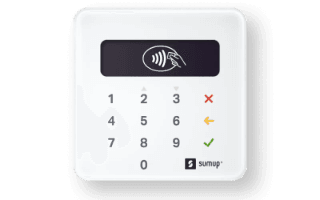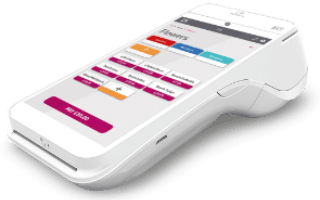In an increasingly cashless society it is important to invest in a good card reader for your business. In this battle of the card readers, we compare the best products from SumUp and takepayments.
SumUp vs takepayments: provider overview
When looking at card readers, there are 3 main types to consider: countertop, portable and mobile. Countertop and portable are quite often referred to as payment terminals and mobile machines are often called readers. Both SumUp and takepayments offer these options and you can compare the full range below.
In this guide, we are comparing their 2 most popular “on-the-go” machines, the SumUp Air and the takepayments Plus.

| Products | SumUp Air, SumUp Air and Cradle, SumUp Solo, SumUp 3G and Printer |
|---|---|
| Payment methods | Contactless, Chip and Pin |
| Alternative payment methods | QR code,Payment link |
| Apple Pay | Yes |
| Google Pay | Yes |
| Connectivity | Bluetooth |
| Requires connection to a phone or tablet | Yes |
| Battery life | 500 sales on a full charge |
| Warranty period | 12 months |

| Products | Takepayments Plus, Countertop, Portable, Mobile |
|---|---|
| Payment methods | Contactless, Chip and Pin, Magnetic swipe |
| Alternative payment methods | Payment link,Over the phone |
| Apple Pay | Yes |
| Google Pay | Yes |
| Connectivity | SIM card,Bluetooth,WiFi |
| Requires connection to a phone or tablet | No |
| Battery life | Designed to last all day |
The SumUp Air vs the takepayments Plus: product overview

SumUp Air

takepayments Plus
Compare rates and fees
Card readers come with a range of rates and fees, these costs are usually made up of the cost of the machine and the cost of transactions made. However, there are often some additional fees to be aware of. Use our guide for further explanations of the different charges you might come across in your research.
Some of the most important ones to note are payment plans
Unlike other card reader providers, takepayments creates personalised payment plans for the individual businesses and depending on your company’s turnover this could be more expensive or less expensive than its competitors. But you will have the reassurance that the payment plans will be fair.
Another thing to note is that takepayments works on a contract basis, whether that is a rolling month by month or annual contract. This is great for businesses that like the stability of having a consistent contract in place. SumUp, however, offers you the flexibility of having no contract at all.
When it comes to settlement periods, SumUp has a current settlement period of 1-3 days, whereas takepayments state that it will payout by the next business day.
Compare features
Now that you’ve compared the costs that come with the SumUp Air and takepayments plus, it is time to turn your head to the features. There are several different features you should look out for when comparing card readers, you can use our guide to find out more information on what these are.
At a glance, you will see that the takepayments plus is peacocking plenty more features compared to the SumUp Air, and that’s great if you’re looking for a card machine that has a printer attached, that accepts cards by magnetic swipe or even a machine that can work without the need of a smartphone or tablet.
But, you can’t underestimate the SumUp Air. Some businesses will be looking for a compact, lightweight machine and the SumUp Air certainly packs a powerful punch in this area.
Another area where the SumUp Air has outstanding performance is its battery life. The SumUp Air has consistent reviews praising its battery life and with the goal of 500 transactions per full charge, it can be argued that it holds the best battery on the market. Whereas the takepayment machine does not specify how much charge the device has, just that it is designed to last all day.
Bottom line
So, who is winning today’s battle of the card readers? Well, at the end of the day, it’s up to you and your business to decide what card machine will work best for you.
Both SumUp and takepayments offer products at the different ends of the card reader spectrum. One offers compact and lightweight readers perfect for SMEs on-the-go and the other offers portable terminals that are great options for restaurants or independent retailers.
Depending on whether you want to commit to a contract for more personalised fees or if you want to pay for a one off machine, you can compare the SumUp and takepayments range below.
Compare the SumUp and takepayments range
More guides on Finder
-
Compare the best mobile card readers
Learn more about how a mobile card reader could benefit your business.
-
Compare the best portable card machines
Discover more about how portable card machines work and whether they are right for your business.
-
Compare virtual terminals 2025
If your business needs to take payments over the phone or by email, a virtual terminal could provide the perfect solution.
-
Card machine fees and charges
We take a closer look at the different fees you face when you get a card machine for your business.
-
Compare myPOS card readers
Learn more about how myPOS card readers work.
-
Compare Stripe card readers
We compare Stripe’s full card reader range.
-
Compare Dojo card readers
Shorter contracts and affordable fees, start comparing Dojo Card readers for your business.
-
Compare takepayments card readers
Learn more about takepayments card readers to see if they are a good fit for your business
-
Compare SumUp card readers
In need of a card reader for your business and not sure where to start? Check out our review on the SumUp card machines.
-
Compare Square card readers
Find out how Square card readers work to see if they are right for you and your business.
